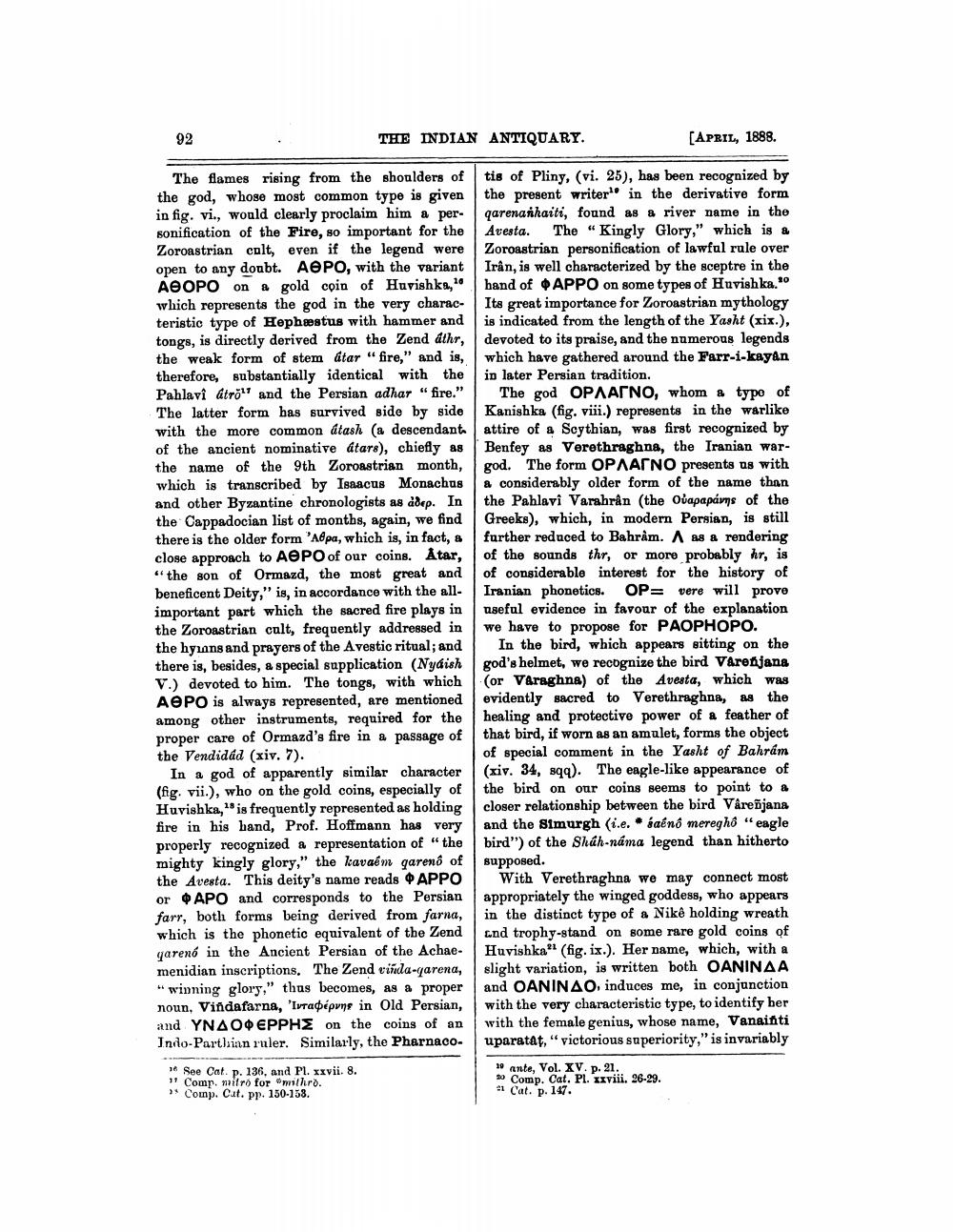________________
92
THE INDIAN ANTIQUARY.
The flames rising from the shoulders of the god, whose most common type is given in fig. vi., would clearly proclaim him a personification of the Fire, so important for the Zoroastrian calt, even if the legend were open to any doubt. AOPO, with the variant ΑΘΟΡΟ on a gold coin of Huvishka, 10 which represents the god in the very characteristic type of Hephaestus with hammer and tongs, is directly derived from the Zend athr, the weak form of stem átar "fire," and is, therefore, substantially identical with the Pahlavi átro and the Persian adhar "fire." The latter form has survived side by side with the more common átash (a descendant. of the ancient nominative átars), chiefly as the name of the 9th Zoroastrian month, which is transcribed by Isaacus Monachus and other Byzantine chronologists as adep. In the Cappadocian list of months, again, we find there is the older form 'Apa, which is, in fact, a close approach to AOPO of our coins. Atar, "the son of Ormazd, the most great and beneficent Deity," is, in accordance with the allimportant part which the sacred fire plays in the Zoroastrian cult, frequently addressed in the hyians and prayers of the Avestic ritual; and there is, besides, a special supplication (Nyáish V.) devoted to him. The tongs, with which AOPO is always represented, are mentioned among other instruments, required for the proper care of Ormazd's fire in a passage of the Vendidád (xiv. 7).
In a god of apparently similar character (fig. vii.), who on the gold coins, especially of Huvishka, is frequently represented as holding fire in his hand, Prof. Hoffmann has very properly recognized a representation of "the mighty kingly glory," the kavaém garenô of the Avesta. This deity's name reads APPO or APO and corresponds to the Persian farr, both forms being derived from farna, which is the phonetic equivalent of the Zend qarené in the Ancient Persian of the Achaemenidian inscriptions. The Zend vinda-garena, "winning glory," thus becomes, as a proper noun, Viñdafarna, 'Ivradépvns in Old Persian, and ΥΝΔΟΦΕΡΡΗΣ on the coins of an Indo-Parthian ruler. Similarly, the Pharnaco
16 See Cat. p. 136, and Pl. xxvii. 8. "Comp. mitro for "mithro.
Comp. Cat. pp. 150-158.
[APRIL, 1888.
tis of Pliny, (vi. 25), has been recognized by the present writer in the derivative form qarenanhaiti, found as a river name in the Avesta. The "Kingly Glory," which is a Zoroastrian personification of lawful rule over Irân, is well characterized by the sceptre in the hand of APPO on some types of Huvishka." Its great importance for Zoroastrian mythology is indicated from the length of the Yasht (xix.), devoted to its praise, and the numerous legends which have gathered around the Farr-i-kayan in later Persian tradition.
The god OPAAгNO, whom a type of Kanishka (fig. viii.) represents in the warlike attire of a Scythian, was first recognized by Benfey as Verethraghna, the Iranian wargod. The form OPɅAгNO presents us with a considerably older form of the name than the Pahlavi Varahrân (the Ouapapávns of the Greeks), which, in modern Persian, is still further reduced to Bahràm. A as a rendering of the sounds thr, or more probably hr, is of considerable interest for the history of Iranian phonetics. OP vere will prove useful evidence in favour of the explanation we have to propose for PAOPHOPO.
In the bird, which appears sitting on the god's helmet, we recognize the bird Varenjana (or Varaghna) of the Avesta, which was evidently sacred to Verethraghna, as the healing and protective power of a feather of that bird, if worn as an amulet, forms the object of special comment in the Yasht of Bahram (xiv. 34, sqq). The eagle-like appearance of the bird on our coins seems to point to a closer relationship between the bird Vâreñjana and the Simurgh (i.e. saéno mereghô "eagle bird") of the Shah-náma legend than hitherto supposed.
With Verethraghna we may connect most appropriately the winged goddess, who appears in the distinct type of a Nikê holding wreath and trophy-stand on some rare gold coins of Huvishka (fig. ix.). Her name, which, with a slight variation, is written both OANINAA and OANINAO, induces me, in conjunction with the very characteristic type, to identify her with the female genius, whose name, Vanainti uparatat, "victorious superiority," is invariably
10 ante, Vol. XV. p. 21..
20 Comp. Cat. Pl. xxviii. 26-29. 21 Cat. p. 147.




